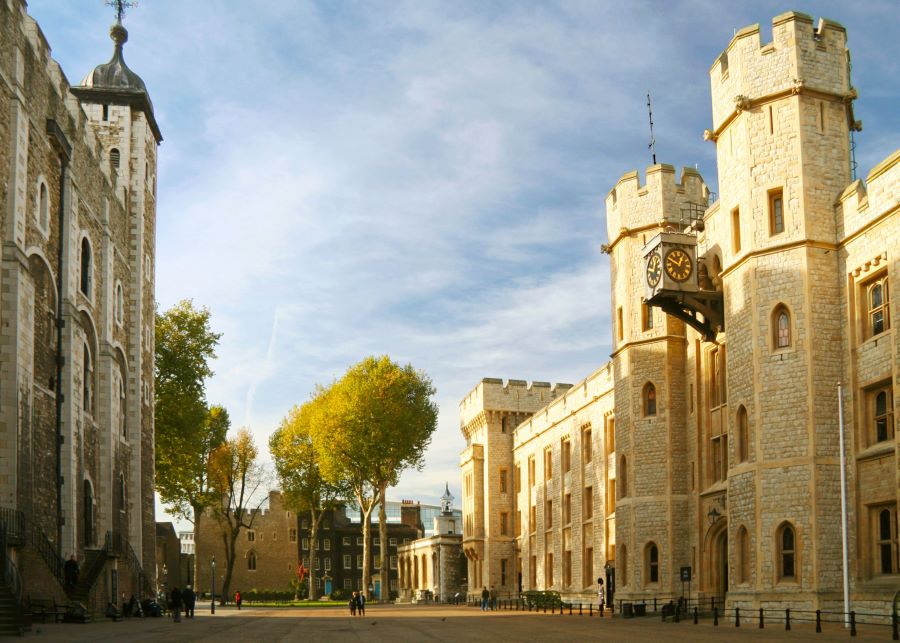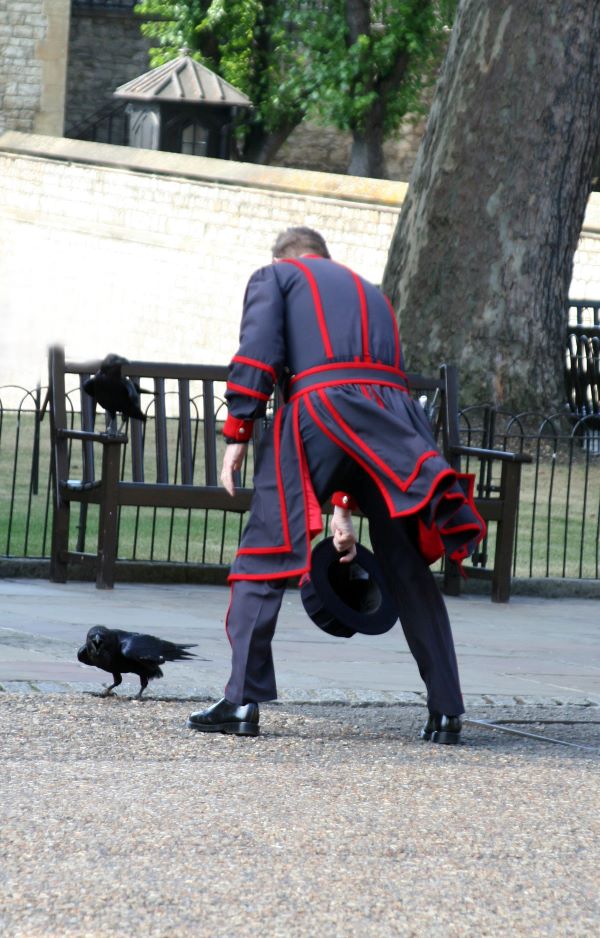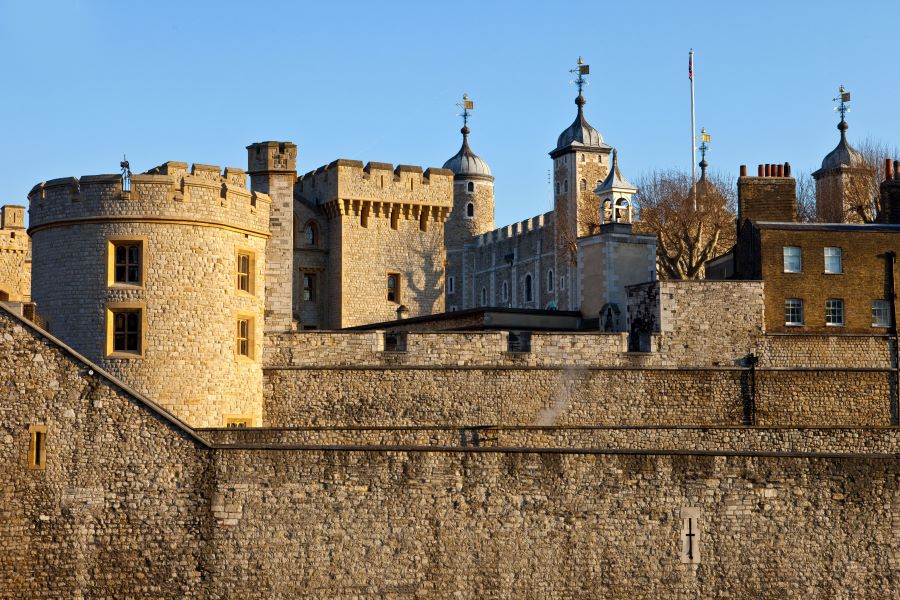The Tower of London has stood as an imposing fortress and garrison since the days of William the Conqueror. Nowadays, it is best known as a prison where many famous historical names spent their final days. However, for 500 years the Tower also served as a royal residence, where a Medieval Palace housed luxurious apartments.
Today the Yeoman warders and their families live within the Tower of London. Better known as Beefeaters, they are the guardians of the Tower and the precious crown jewels. Although not usually a main residence, the Tower of London was one of the palaces frequented by medieval monarchs up until the 16th century.
As well as a residence and a place to hold court while in London, the Tower offered a place of refuge for monarchs during uprisings. In this article, I shall look at:
- Who lives in the Tower of London today
- Some of the monarchs who made the Tower’s Medieval Palace their home in days gone by
- Animals that have lived at the Tower of London

The Beefeaters
The Beefeaters are one of the most iconic sights of London. Their famous, brightly colored uniform has been worn with pride since Tudor times. These Yeoman warders originally formed part of the Yeoman of the Guard who protected the monarch when traveling the country.
However, when Henry VIII stopped using the Tower as a residence, he needed a trusted unit to guard the tower. In particular, he needed the Yeomen warders to guard the crown jewels and the increasing number of prisoners the King sent to the Tower.
Today’s Yeoman warders wear their famed dark blue uniform with red trimmings for their everyday tasks. They don their traditional red uniforms to carry out ceremonial duties.
How Do You Become a Yeoman Warder?
At any given time between 30 and 40 Yeoman warders live at the Tower of London. To be considered for the role you need 22 years of military service (source).
You also need to have achieved the rank of warrant officer and been awarded medals for good conduct and long service.
While much of the day is spent engaging with inquisitive tourists and pointing them in the right direction, there is still a serious side to the job. The Yeoman warders remain guardians of the Tower and all that it contains. This includes protecting the precious Crown jewels housed in the Jewel Tower.
The Ceremony of the Keys
Every night, once the last of the tourists have left, the Tower is locked up.
The Ceremony of the Keys has been a part of the Tower of London tradition for over 700 years. At 9.53 pm every night, the chief of the Yeoman warders meets a military escort to lock the Tower of London for the night.
The ceremony is completed by 10.05 pm and you can pre-book to witness this tradition. However, do not book if you have a habit of tardiness, as you won’t be admitted if you miss the designated entrance time!
The following video shows the ceremony in practice.
Part of a Community
The Yeoman warders and their families form part of a community of around 150 residents within the Tower grounds.
The families are housed in the outer wall of the tower and have to abide by certain rules. For example, if you want to head out into London at night, you have to get permission from security first.
However, for most that is considered a minor inconvenience to live in such a historic place. The properties can be reasonably spacious with some set over 4 stories, replete with quirky features such as arrow slits in the walls.
The ‘village’ also has a chapel, surgery and its own pub!

A Royal Residence for 500 Years
While predominantly an imposing fortress reminding people who is in charge, the Tower of London was also used as a royal residence. Successive monarchs added to the impressive stone tower first built under the watchful eye of William the Conqueror.
For William, the tower was largely a symbol, a sign to the recently conquered populace of his power and his reign over them. The fortress was also a handy defensive structure in case of rebellion in his recently won kingdom.
Succeeding monarchs, particularly the Plantagenets, still saw the Tower as an impenetrable castle, somewhere to withstand a siege in times of trouble. However, they also started to use the Tower more as a residence and set about building a palace fit for royalty within the Tower grounds.
Other palaces such as the Palace of Westminster and Windsor Castle may have been higher up the pecking order than the Tower of London as residency of choice.
A medieval king also often traveled the country, trying to ensure peace in their lands. Therefore the monarch never stayed at the Tower for any great length of time.
However, there was no denying the symbolic status of using the Tower as a residence and running government business from within its solid walls.
The Medieval Palace
In the thirteenth century, King Henry III was fascinated by architecture and was one of the great royal builders. He spent thousands of pounds renovating the residential areas of his palaces. This included the Palace of Westminster. Henry also rebuilt Westminster Abbey.
Although the Tower only hosted monarchs for short stays, Henry III did not see why they shouldn’t be luxurious stays. He set about building the Medieval Palace on the residential section of the Tower.
Much of the palace has since gone. However, St. Thomas Tower, Lanthorn Tower, and Wakefield Tower provide a taste to visitors of how the palace would have been furnished and decorated.
St. Thomas Tower was an extension built by Henry’s son, Edward I. Edward loved a castle, using them to show off his royal power in places like Wales.
His additions to the Tower of London were more practical than his father’s. The fortifications he built began to give the Tower the look we recognize today.
The tower looked directly over the Thames in Edward’s day. Mooring up on the royal boat, he could hop out and be straight into his royal residency from the jetty.
However, that was not very often. Edward I reigned from 1272 to 1307, but only ever stayed at the Tower for 53 nights. His son King Edward II opted for the Lantern Tower when he stayed over.
| Built | During Reign | |
| Wakefield Tower | 1220 – 1240 | Henry III |
| Lanthorn Tower | 1238 – 1272 | Henry III |
| St Thomas Tower | 1275 – 1279 | Edward I |
A Residency and a Shelter
The Tower has always been an imposing fortress first and foremost. A place that shouts power and strength. Therefore, while the Plantagenets used the Tower as a residency more than their predecessors, any building extensions kept in mind the Tower should provide a place of protection during times of uprising.
In 1381, Richard II would be grateful for this, taking refuge within the Tower during the Peasants Revolt.
The uprising developed for several reasons, including the issue of low pay and the introduction of a poll tax. Under the guidance of Wat Tyler, the peasants marched on London.
King Richard was only 14 years old when faced with this serious revolt. He took refuge with his counselors behind the sturdy walls of the Tower. The infrequently used residence was now performing its chief task as a fortress.
However, the Tower was not as impenetrable as first believed. Richard had left to meet with Wat Tyler at Mile End when a crowd entered the Tower through an opened gate.
They ransacked the Tower and killed the Archbishop of Canterbury and the King’s Treasurer. The life of the future King Henry was spared as he was so young.
Turbulent Times
The Wars of the Roses pitted the House of Lancaster and the House of York against one another for the throne. The Tower of London continued to play the role of a symbolic structure, one which lends legitimacy of power to he who holds it. What this also meant was the lines between residency, fortress and prison became even more blurred.
Indeed, the Tower was becoming more of a prison than a residence. One of the unfortunate ‘residents’ to find out that you did not always leave the Tower was Henry VI.
He was first sent to the Tower by the Yorkist Edward IV in 1465, where it is said Edward asked for him to be treated kindly.
Henry VI was restored to the throne in 1470, but after the triumphant return of Edward, soon found himself back in the Tower of London. This time there would be no happy ending.
Henry died in the Tower on May 21st, 1471, very likely murdered on the orders of Edward IV.
Princes in the Tower
Henry VI was not the only one to find out that the Tower was not somewhere you want to be sent. The Princes in the Tower are probably the most famous residents of this historic site. The sons of Edward IV, the Princes found themselves ‘residents’ in the tower after their father’s death.
Most people point the finger at Richard III for what happened next. However, it is a topic that still causes huge debate to this day. What we do know is that the oldest prince was now King Edward V.
The Tower still contained luxurious apartments for royal residents. The Princes may have thought this was where Uncle Richard was escorting them to. However, the boys would disappear, assumed murdered. Uncle Richard became King Richard III.
The Tower had always hosted famous prisoners, but the trend was on an upward spiral. The famous residents from thereon tended to be prisoners. It was a trend that only increased under the Tower’s final resident monarch, Henry VIII.

The Last Royal Resident
Henry VIII had a raft of palaces that he preferred to stay at rather than the Tower. He was using the tower more as a way to consolidate his power. Among the famous names imprisoned in the tower at this time were Thomas More, Thomas Cromwell, John Fisher, Catherine Howard, and Anne Boleyn.
However, three years before Anne Boleyn’s imprisonment and execution, Henry was splashing the cash on the tower’s residential area.
Since the days of Richard II, a coronation began with a procession from the Tower to Westminster Abbey. Both the King and Queen feasted at the Tower the night before the coronation of Anne Boleyn.
The Tower had already stopped being considered a primary royal residency long before Henry VIII came to power. Apart from ceremonies, Henry VIII was the last to use the Tower for residential purposes.
Greenwich, Hampton Court, and later Buckingham Palace became the preferred choice of royal residences in London.
Not Just People
From the early thirteenth century, the Tower of London has been the residence of an assorted collection of animals. The Menagerie first came about when monarchs gave animals as gifts to fellow monarchs. Elephants, leopards, lions, and monkeys were some of the animals housed at the Tower.
One of the most noteworthy beasts that lived at the Tower was a polar bear. It was presented as a gift to Henry III in 1252 (source).
Most of us would think this was not the ideal gift. Indeed, it was kept muzzled and chained for most of the time. However, now and then it was let loose in the Thames to catch fish, although still suitably tethered to stop it from going on to terrorize the locals.
The Menagerie was maintained until 1835 when welfare concerns saw it close. The animals housed at the Tower helped found London Zoo in Regent’s Park which has become another of London’s top tourist spots.
Then There Are Those Who Never Leave
There are still reported to be famous residents at the Tower of London. However, they come as ghostly apparitions. The Tower is reputed to be haunted by many famous historical figures who perished a gruesome death at the hands of the executioner.
Anne Boleyn, Arabella Stuart, and the white lady in the White Tower are a sample of the cast of phantoms you may come across at the Tower. Some of those who live at the Tower have reported strange goings on.
